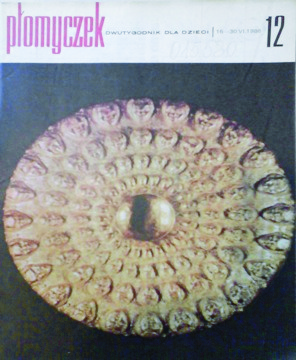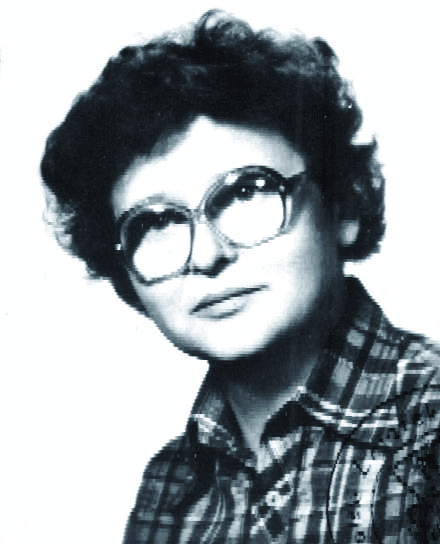Title of the work
Country of the First Edition
Country/countries of popularity
Original Language
First Edition Date
First Edition Details
Aleksandra Witkowska, "Orfeusz i Eurydyka,” Płomyczek 12 (1988): 10–11.
ISBN
Genre
Adaptation of classical texts*
Adaptations
Myths
Target Audience
Children (9–11 years old)
Cover

Courtesy of Oficyna Wydawnicza AMOS, the owner of copyright.
Author of the Entry:
Summary: Maryana Shan, University of Warsaw, vespertime@ukr.net
Analysis: Marta Pszczolińska, University of Warsaw, m.pszczolinska@al.uw.edu.pl
Peer-reviewer of the Entry:
Katarzyna Marciniak, University of Warsaw, kamar@al.uw.edu.pl
Elżbieta Olechowska, University of Warsaw, elzbieta.olechowska@gmail.com

Photograph courtesy of the Author.
Aleksandra Witkowska (Danecka)
[Stephen Farlough] , b. 1945
(Author)
Aleksandra Danecka, née Witkowska, born on May 2, 1945, in Warsaw, is a translator of Arabic poetry and author of historical monographs, novels, radio plays, and hundreds of other literary, scholarly and popular academic publications, as well as a painter. Many of her works were published under her maiden name.
Witkowska worked also for the Instytut Książki i Czytelnictwa [The Polish Book and Readership Institute] (1969–1974), the monthly Prezentacje (1984–1988), the children’s magazine Płomyczek (1988–1989), and since 1992, for the Polish Television. Her early publications include topics from library science; also — jointly with the Arabist Janusz Danecki — she published several translations of classical Arabic literary texts (for example Ibn Hazm’s Ring of the Dove, 1976, or al–Hamadāni’s Maqamat, 1989). In 1989, she wrote a history of the Arabs for children entitled Synowie pustyni [Sons of the Desert]. The book is an attempt to present history in a way that differs significantly from the textbook narrative. The aim was to encourage children to read other books on the subject. In 1993, using the pen-name Stephen Farlough, she published a book about the classical and medieval history of homoeroticism, entitled Inna miłość. Opowieści o znanych i nieznanych homoseksualistach [A Different Love. Tales of Known and Unknown Gays]. The Polish Radio aired a few of her plays; for one of them — Tajemnica Królowej Saby [The Mystery of the Queen of Sheba] 1985, she also received an award in a Polish Radio’s Channel Four Competition. Her articles in periodicals are devoted to the translation of poetry as well as the popularization of history and classical literature. A couple of years ago she started painting, trying her hand at portraits, landscapes and still lives. She is still developing her own style as a painter.
Based on material kindly provided by the Author.
Bio prepared by Joanna Kłos, University of Warsaw, joanna.klos@student.uw.edu.pl
Summary
Based on: Katarzyna Marciniak, Elżbieta Olechowska, Joanna Kłos, Michał Kucharski (eds.), Polish Literature for Children & Young Adults Inspired by Classical Antiquity: A Catalogue, Faculty of “Artes Liberales”, Warsaw: University of Warsaw, 2013, 444 pp.
Orpheus, a famous ancient poet and musician from Thrace, was given the lyre by Apollo himself who made him a master of the arts of music and poetry. The beauty of Orpheus’ wife – the nymph Eurydice, turned out to be the reason for her sufferings. Pursued by Aristaeus, a shepherd, the nymph was bitten by a serpent and died. Her husband could not live without her and travelled to the Underworld, where, with the help of his divine music he dealt with Cerberus and Charon; he also met the shades of Sisyphus and Tantalus, and finally, he convinced Hades and his wife Persephone to return Eurydice to life, on the condition that he would walk in front of Eurydice and would not turn back to look at her until they came out of the Underworld. In this adaptation of the myth, as they were walking, the nymph asked him to trust that she would follow and to keep playing his lyre. Unfortunately, Orpheus tripped over a stone and fell. Bending down to pick up his instrument, he accidentally saw behind him Eurydice’s face. At the same moment, she vanished forever. Orpheus was struck with unbearable pain and grief. Nature reacted to his mournful music: the author gives an example of mesmerized old oaks stilled by his music.
Analysis
The story in an accessible way shows to children the power of music, the power of love, the inevitability of human fate and the irrevocability of death. Special attention is paid to the role of divine music.
The author presents the myth of Orpheus and Eurydice as being of Thracian origin. She introduces Thrace as an independent region outside of Greece, ruled by Oeagrus and Calliope – the parents of the greatest poet and musician ever, Orpheus. Thrace is here strictly connected with nature. The music played by Orpheus on Apollo’s lyre tames the wildlife – the whole nature of Thrace is overwhelmed by its charm. In this land, brimming with music, Eurydice, the beautiful tree nymph, completes the image of tamed nature in Orpheus’ ideal life. Although the beauty of the music complements the beauty of nature and is somehow the key to a better life, it does not last forever. An unforeseen death comes when Thrace is deprived of the protective power of the music of the golden lyre. The power of music which could move nature, cannot console the musician deprived of his beloved.
From this moment on, Orpheus has to act with a single purpose and not renounce performing for pleasure and fame. He is presented as grieving but determined: he dares to embark alone on his seemingly hopeless quest. Armed with his lyre, he begins the journey to rescue his wife from the world of the dead. The years devoted to music pay off, as he needs to move and enchant hostile or indifferent beings: Cerberus, Charon, and Persephone.
The image of the Underworld, a gloomy and hopeless place, contrasts with the fabulous Thrace. Owing to Orpheus, hope enters the Underworld for the first time and even the eternally condemned, like Sisyphus and Tantalus, may have a moment of relief. Music and the power of love touch also the heart of Persephone who sways her mighty husband. What is unusual, Witkowska gives the voice to Eurydice. In Ovid’s Metamorphoses, she only whispers “farewell” (vale*) before disappearing forever. Here, she talks to her husband the whole time and reassures him that she is just behind him as if she were not a shadow but a person of flesh and blood. Thus Orpheus’ repeated loss is not the result of his failure to resist temptation but rather a fateful misfortune. It seems as if her voice and warnings were not enough to conquer death when the divine music stopped.
Unlike the other unhappy ending, when Orpheus is torn apart alive, a scene usually considered inappropriate for children, the author paints a moving image of Orpheus pouring his pain and longing into his music, keeping nature enchanted until he dies. For the last time, music acts as a protagonist in the myth.
* Ov. Met. X 62.
Further Reading
Aleksandra Danecka, http://www.multibiblioteka.waw.pl/index.php?option= com_content&task=view&id=230&Itemid=19 (accessed 29.04.2013, link does not function currently).
Apollodorus, The Library, I 3. 2–3, trans. James George Frazer, vol. 1, London: William Heinemann, New York: G. P. Putnam’s Sons, 1921, 16–19 (accessed: January 27, 2022).
Ovid, Metamorphoses, X 8–63, trans. Frank Justus Miller, vol. 2, Cambridge, MA: Harvard University Press, London William Heinemann Ltd., 1916, 64–69 (accessed: January 27, 2022).
Virgil, Georgics, IV 453–527, trans. H. Rushton Fairclough, London: William Heinemann, New York: G. P. Putnam’s Sons, 1916, 228–233 (accessed: January 27, 2022.
Addenda
Illustrations: Teresa Jaskierny.


